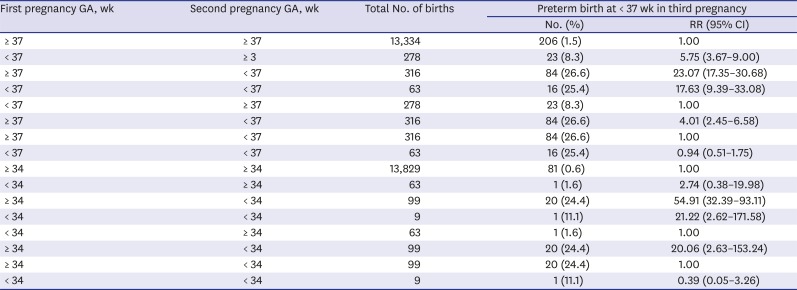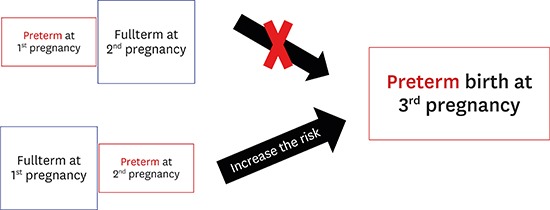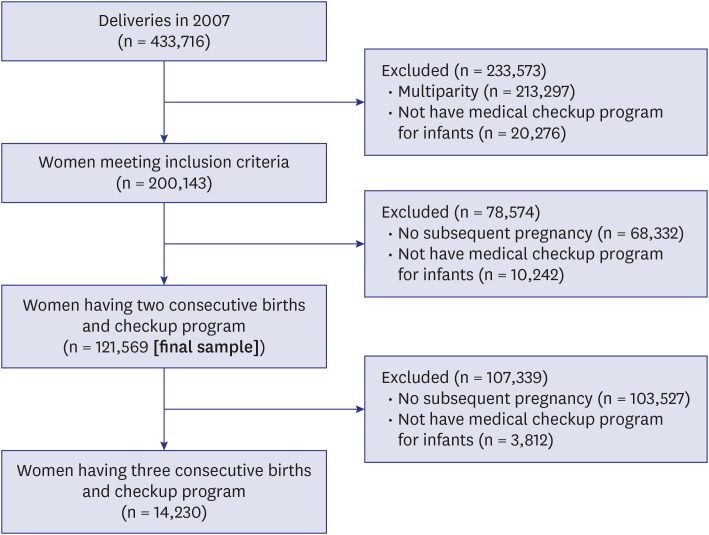1. Ananth CV, Joseph KS, Oyelese Y, Demissie K, Vintzileos AM. Trends in preterm birth and perinatal mortality among singletons: United States, 1989 through 2000. Obstet Gynecol. 2005; 105(5 Pt 1):1084–1091. PMID:
15863548.
2. Demissie K, Rhoads GG, Ananth CV, Alexander GR, Kramer MS, Kogan MD, et al. Trends in preterm birth and neonatal mortality among blacks and whites in the United States from 1989 to 1997. Am J Epidemiol. 2001; 154(4):307–315. PMID:
11495853.
3. Wen SW, Smith G, Yang Q, Walker M. Epidemiology of preterm birth and neonatal outcome. Semin Fetal Neonatal Med. 2004; 9(6):429–435. PMID:
15691780.
4. Martin JA, Hamilton BE, Sutton PD, Ventura SJ, Mathews TJ, Kirmeyer S, et al. Births: final data for 2007. Natl Vital Stat Rep. 2010; 58(24):1–85.
5. Romero R, Espinoza J, Kusanovic JP, Gotsch F, Hassan S, Erez O, et al. The preterm parturition syndrome. BJOG. 2006; 113(Suppl 3):17–42.
6. Goldenberg RL, Culhane JF, Iams JD, Romero R. Epidemiology and causes of preterm birth. Lancet. 2008; 371(9606):75–84. PMID:
18177778.
7. Bloom SL, Yost NP, McIntire DD, Leveno KJ. Recurrence of preterm birth in singleton and twin pregnancies. Obstet Gynecol. 2001; 98(3):379–385. PMID:
11530116.
8. Carr-Hill RA, Hall MH. The repetition of spontaneous preterm labour. Br J Obstet Gynaecol. 1985; 92(9):921–928. PMID:
4041398.
9. Martin JA, Hamilton BE, Ventura SJ, Osterman MJ, Kirmeyer S, Mathews TJ, et al. Births: final data for 2009. Natl Vital Stat Rep. 2011; 60(1):1–70.
10. Wei J, Wu QJ, Zhang TN, Shen ZQ, Liu H, Zheng DM, et al. Complications in multiple gestation pregnancy: a cross-sectional study of ten maternal-fetal medicine centers in China. Oncotarget. 2016; 7(21):30797–30803. PMID:
27127170.
11. Facco FL, Nash K, Grobman WA. Are women who have had a preterm twin delivery at greater risk of preterm birth in a subsequent singleton pregnancy? Am J Obstet Gynecol. 2007; 197(3):253.e1–253.e3. PMID:
17826408.
12. Schaaf JM, Hof MH, Mol BW, Abu-Hanna A, Ravelli AC. Recurrence risk of preterm birth in subsequent singleton pregnancy after preterm twin delivery. Am J Obstet Gynecol. 2012; 207(4):279.e1–279.e7. PMID:
22917487.
13. Schaaf JM, Hof MH, Mol BW, Abu-Hanna A, Ravelli AC. Recurrence risk of preterm birth in subsequent twin pregnancy after preterm singleton delivery. BJOG. 2012; 119(13):1624–1629. PMID:
23078576.
14. Goldenberg RL, Goepfert AR, Ramsey PS. Biochemical markers for the prediction of preterm birth. Am J Obstet Gynecol. 2005; 192(5):Suppl. S36–S46. PMID:
15891711.
15. Kang EJ, Seo JH, Kim LY, Park GU, Oh MJ, Park PJ, et al. Pregnancy-associated risk factors of postpartum breast cancer in Korea: a Nationwide Health Insurance Database Study. PLoS One. 2016; 11(12):e0168469. PMID:
27977789.
16. Mercer BM, Goldenberg RL, Meis PJ, Moawad AH, Shellhaas C, Das A, et al. The preterm prediction study: prediction of preterm premature rupture of membranes through clinical findings and ancillary testing. Am J Obstet Gynecol. 2000; 183(3):738–745. PMID:
10992202.
17. Smith GC, Pell JP, Dobbie R. Interpregnancy interval and risk of preterm birth and neonatal death: retrospective cohort study. BMJ. 2003; 327(7410):313. PMID:
12907483.
18. Conde-Agudelo A, Rosas-Bermúdez A, Kafury-Goeta AC. Birth spacing and risk of adverse perinatal outcomes: a meta-analysis. JAMA. 2006; 295(15):1809–1823. PMID:
16622143.
19. Goldenberg RL, Andrews WW, Faye-Petersen O, Cliver S, Goepfert AR, Hauth JC. The Alabama Preterm Birth Project: placental histology in recurrent spontaneous and indicated preterm birth. Am J Obstet Gynecol. 2006; 195(3):792–796. PMID:
16846583.
20. Ananth CV, Kirby RS, Vintzileos AM. Recurrence of preterm birth in twin pregnancies in the presence of a prior singleton preterm birth. J Matern Fetal Neonatal Med. 2008; 21(5):289–295. PMID:
18446653.
21. Rydhstroem H. Gestational duration in the pregnancy after a preterm twin delivery. Am J Obstet Gynecol. 1998; 178(1 Pt 1):136–139. PMID:
9465817.
22. Menard MK, Newman RB, Keenan A, Ebeling M. Prognostic significance of prior preterm twin delivery on subsequent singleton pregnancy. Am J Obstet Gynecol. 1996; 174(5):1429–1432. PMID:
9065107.
23. Slattery MM, Morrison JJ. Preterm delivery. Lancet. 2002; 360(9344):1489–1497. PMID:
12433531.
24. Loudon JA, Sooranna SR, Bennett PR, Johnson MR. Mechanical stretch of human uterine smooth muscle cells increases IL-8 mRNA expression and peptide synthesis. Mol Hum Reprod. 2004; 10(12):895–899. PMID:
15489245.
25. Iams J. Prevention of preterm birth. N Engl J Med. 1998; 338(1):54–56. PMID:
9414333.
26. Ananth CV, Vintzileos AM. Epidemiology of preterm birth and its clinical subtypes. J Matern Fetal Neonatal Med. 2006; 19(12):773–782. PMID:
17190687.
27. Kyrklund-Blomberg NB, Granath F, Cnattingius S. Maternal smoking and causes of very preterm birth. Acta Obstet Gynecol Scand. 2005; 84(6):572–577. PMID:
15901269.
28. Mathews TJ, Miniño AM, Osterman MJ, Strobino DM, Guyer B. Annual summary of vital statistics: 2008. Pediatrics. 2011; 127(1):146–157. PMID:
21173001.







 PDF
PDF Citation
Citation Print
Print





 XML Download
XML Download